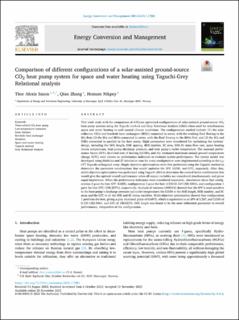| dc.contributor.author | Sazon, Thor Alexis Salazar | |
| dc.contributor.author | Zhang, Qian | |
| dc.contributor.author | Nikpey Somehsaraei, Homam | |
| dc.date.accessioned | 2023-12-07T13:17:05Z | |
| dc.date.available | 2023-12-07T13:17:05Z | |
| dc.date.created | 2023-11-27T10:48:44Z | |
| dc.date.issued | 2023 | |
| dc.identifier.citation | Sazon, T. A., Zhang, Q., & Nikpey, H. (2024). Comparison of different configurations of a solar-assisted ground-source CO2 heat pump system for space and water heating using Taguchi-Grey Relational analysis. Energy Conversion and Management, 300, 117881. | en_US |
| dc.identifier.issn | 0196-8904 | |
| dc.identifier.uri | https://hdl.handle.net/11250/3106431 | |
| dc.description.abstract | This work deals with the comparison of different optimized configurations of solar-assisted ground-source CO2 heat pump systems using the Taguchi method and Grey Relational Analysis (GRA) when used for simultaneous space and water heating in cold coastal climate conditions. The configurations studied include: (1) the solar collectors (SCs) and borehole heat exchangers (BHEs) connected in series, with the working fluid flowing to the SCs first; (2) the SCs and BHEs connected in series, with the fluid flowing to the BHEs first; and (3) the SCs and BHEs connected in parallel to the heat pump. Eight parameters were considered for optimizing the systems’ design, including the BHE length, BHE spacing, BHE number, SC area, BHE-SC mass flow rate, space heating return temperature, heat pump discharge pressure, and heat pump’s outlet temperature. The seasonal performance factor (SPF), levelized cost of heating (LCOH), and the estimated maximum annual ground temperature change (GTC) were chosen as performance indicators to evaluate system performance. The system model was developed using Modelica and 27 simulation runs for every configuration were implemented according to the L27 (93) Taguchi orthogonal array. Single objective optimizations were first performed using the Taguchi method to determine the parameter combinations that would optimize the SPF, LCOH, and GTC, separately. After that, multi-objective optimization was performed using Taguchi-GRA to determine the control factor combination that would give the optimal overall performance when all output variables are considered simultaneously and given equal importance. When the performance indicators were considered separately, simulations show that configuration 2 gave the best SPF (4.025), configuration 3 gave the best LCOH (0.124 USD/kWh), and configuration 1 gave the best GTC (100.257%), respectively. Analysis of variance (ANOVA) showed that the SPF is most sensitive to the heat pump’s discharge pressure and outlet temperature; the LCOH to the BHE length, BHE number, and SC area; and the GTC to all the BHE and SC sizing variables. Multi-objective optimization showed that configuration 1 performs the best, giving a grey relational grade of 0.6875, which is equivalent to an SPF of 3.267, and LCOH of 0.155 USD/kWh, and GTC of 100.021%. BHE length was found to be the most influential parameter to overall performance, irrespective of the configuration. | en_US |
| dc.language.iso | eng | en_US |
| dc.publisher | Elsevier | en_US |
| dc.rights | Navngivelse 4.0 Internasjonal | * |
| dc.rights.uri | http://creativecommons.org/licenses/by/4.0/deed.no | * |
| dc.title | Comparison of different configurations of a solar-assisted ground-source CO2 heat pump system for space and water heating using Taguchi-Grey Relational analysis | en_US |
| dc.type | Peer reviewed | en_US |
| dc.type | Journal article | en_US |
| dc.description.version | publishedVersion | en_US |
| dc.rights.holder | © The Author(s) 2023 | en_US |
| dc.subject.nsi | VDP::Matematikk og Naturvitenskap: 400 | en_US |
| dc.subject.nsi | VDP::Teknologi: 500 | en_US |
| dc.source.volume | 300 | en_US |
| dc.source.journal | Energy Conversion and Management | en_US |
| dc.identifier.doi | 10.1016/j.enconman.2023.117881 | |
| dc.identifier.cristin | 2202730 | |
| cristin.ispublished | true | |
| cristin.fulltext | original | |
| cristin.qualitycode | 1 | |

